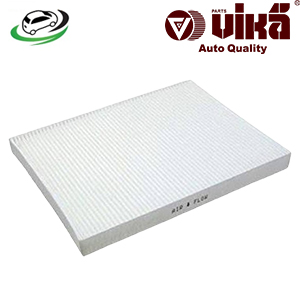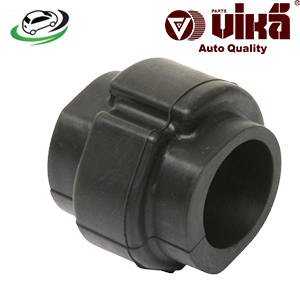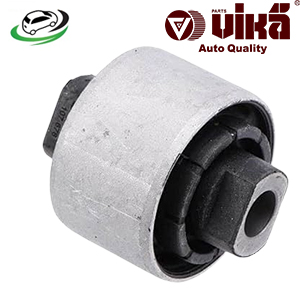-25%
Get Front Lower Inner Control Arm Bush Audi B5 A4 FWD 1.8T/Audi B5 A4 FWD V6 12v/Audi B5 A4 FWD V6 30v/ VW Passat B5 4D0407182E
Control arm bushes, also known as control arm bushings, are critical components in a vehicle’s suspension system. These small yet significant parts connect the control arms to the frame or body of the vehicle, allowing for flexible movement and absorbing shocks from the road. This guide delves into the function, construction, types, signs of wear, diagnosis, and maintenance of control arm bushes.
Function and Importance
Control arm bushes serve several essential functions in a vehicle’s suspension system:
- Vibration and Shock Absorption: They absorb shocks and vibrations from the road, providing a smoother and more comfortable ride.
- Movement Flexibility: They allow the control arms to pivot, accommodating the up and down motion of the wheels and ensuring proper wheel alignment.
- Noise Reduction: By absorbing vibrations and shocks, control arm bushes help reduce noise from the suspension system.
The importance of control arm bushes cannot be overstated. They play a crucial role in maintaining vehicle stability, ensuring proper wheel alignment, and providing a comfortable driving experience. Worn or damaged bushes can lead to various handling and safety issues, making regular inspection and maintenance vital.
Construction and Types
Control arm bushes are typically made from rubber, polyurethane, or a combination of metal and rubber. The choice of material affects the performance and lifespan of the bushes:
- Rubber Bushes: These are the most common type, offering good flexibility and vibration absorption. However, they can wear out more quickly than other materials.
- Polyurethane Bushes: These are more durable and resistant to wear and tear than rubber bushes. They provide better performance but can transmit more vibration and noise.
- Metal-Backed Bushes: These combine rubber or polyurethane with a metal sleeve for added strength and durability.
There are two main types of control arm bushes:
- Inner Control Arm Bushes: Located at the chassis end of the control arm, these bushes are responsible for connecting the control arm to the vehicle’s frame.
- Outer Control Arm Bushes: Located at the wheel end of the control arm, these bushes connect the control arm to the steering knuckle or spindle.
Signs of Wear and Symptoms
1. Unusual Noises
One of the most common symptoms of worn control arm bushings is unusual noises coming from the suspension system. These noises can manifest in several ways:
- Clunking or Knocking: This sound is often heard when driving over bumps, potholes, or rough roads. It occurs because the worn bushings no longer hold the control arm securely, allowing it to move excessively and produce noise.
- Creaking or Squeaking: These noises can occur when turning the steering wheel or driving over uneven surfaces. They are caused by the friction between the worn bushing and the metal components of the suspension system.
2. Poor Handling and Stability
Worn control arm bushings can significantly affect the handling and stability of the vehicle. Symptoms related to poor handling include:
- Loose or Unstable Feel: The vehicle may feel loose or unstable, particularly during cornering or when driving on uneven roads. This is because the worn bushings allow excessive movement of the control arm, leading to a lack of control.
- Body Roll: The vehicle may experience increased body roll or sway when turning, as the bushings can no longer provide the necessary support to the control arms.
3. Vibration and Shaking
Excessive vibration or shaking, especially in the steering wheel or the vehicle’s body, can indicate worn control arm bushings. This happens because the bushings can no longer effectively absorb shocks and vibrations from the road, leading to a rougher ride.
4. Uneven Tire Wear
Control arm bushings play a crucial role in maintaining proper wheel alignment. When they wear out, they can cause the wheels to become misaligned, leading to uneven tire wear. Signs of uneven tire wear include:
- Feathering or Cupping: The tread on one side of the tire wears down more quickly than the other, resulting in a feathered or cupped appearance.
- Inner or Outer Edge Wear: The inner or outer edges of the tires may wear down more rapidly than the rest of the tread, indicating misalignment issues.
5. Steering Problems
Problems with steering can also be a sign of worn control arm bushings. These symptoms may include:
- Difficulty Steering: The steering may feel stiff or require more effort, particularly when making low-speed turns or parking.
- Wandering or Pulling: The vehicle may wander or pull to one side, especially when driving straight. This is due to the control arms not holding the wheels in proper alignment.
6. Excessive Play in the Steering Wheel
Excessive play or looseness in the steering wheel can indicate worn control arm bushings. This symptom is characterized by a feeling of slack or delay in the steering response, making it challenging to maintain control of the vehicle.
Diagnosis and Inspection
Diagnosing worn control arm bushes involves both visual inspection and physical testing:
- Visual Inspection: Look for visible signs of wear, such as cracks, tears, or deformation in the bushes. Check for any signs of oil or grease contamination, which can deteriorate rubber bushes.
- Physical Testing: Lift the vehicle and use a pry bar to check for excessive movement in the control arms. Excessive play can indicate worn or damaged bushes.
- Professional Inspection: If you suspect that the control arm bushes are worn, it is advisable to have a professional mechanic perform a thorough inspection. They can use specialized tools to accurately diagnose the issue.
Replacement and Maintenance
Replacing control arm bushes requires precision and the right tools. Here are the general steps involved:
- Preparation: Secure the vehicle on jack stands and remove the wheels to access the control arms.
- Remove Control Arms: Disconnect the control arms from the frame and the steering knuckle. This may involve removing bolts, nuts, and other suspension components.
- Remove Old Bushes: Use a press or a specialized tool to remove the old bushes from the control arms.
- Install New Bushes: Press the new bushes into the control arms, ensuring they are properly seated.
- Reinstall Control Arms: Reattach the control arms to the frame and the steering knuckle, ensuring all bolts and nuts are securely tightened.
- Alignment: After replacing the control arm bushes, a professional wheel alignment is recommended to ensure proper vehicle handling and tire wear.
Maintenance Tips
- Regular Inspections: Periodically inspect the control arm bushes for signs of wear or damage, especially if driving on rough roads.
- Avoid Contaminants: Keep oil, grease, and other contaminants away from rubber bushes to prevent premature deterioration.
- Alignment Checks: Regular wheel alignment checks can help identify issues with control arm bushes before they become severe problems.
- Use Quality Parts: When replacing control arm bushes, opt for high-quality parts that match your vehicle’s specifications for better performance and longevity.
Follow us on Facebook for more parts.



